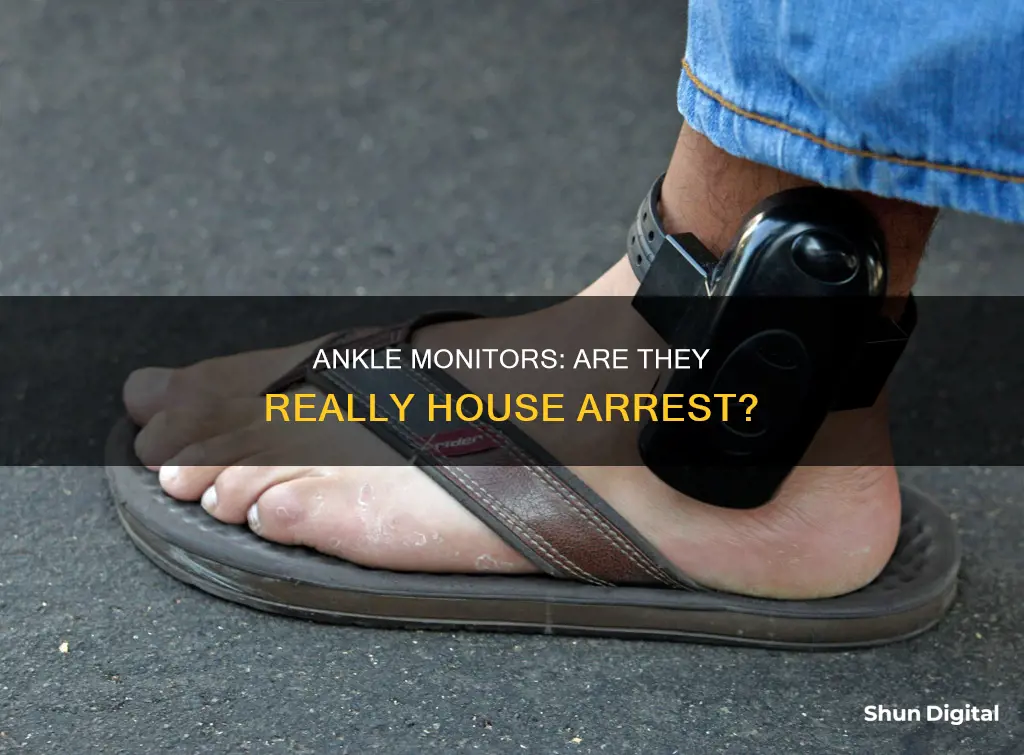
Ankle monitors are often used as an alternative to incarceration, with the number of people wearing them rising during the pandemic as jails looked to reduce their incarcerated populations. They are typically used on people awaiting trial, on probation, or on parole, and can also be used to enforce restraining orders or restrictions on alcohol consumption. The monitors use GPS or radio frequency technology to track the wearer's location, sending alerts to the relevant authorities if they leave a designated area. While they are intended to reduce prison populations and allow people to be punished without being incarcerated, critics argue that they are ineffective at reducing reoffending and can cause financial and social difficulties for those who wear them.
| Characteristics | Values |
|---|---|
| Purpose | Supervision of individuals on parole or house arrest |
| Users | People awaiting trial, serving probation, on parole, facing immigration proceedings, or under house arrest |
| Technology | GPS or radio frequency |
| Data transmitted | Location, alcohol consumption |
| Components | Ankle bracelet, on-site receiver, remote receiver |
| Alert features | If the wearer leaves the designated area, if the unit requires charging, if the wearer tampers with the device, if the wearer nears an off-limits location, if the bracelet detects alcohol, if the wearer strays from a specified location or schedule, if the system malfunctions |
| Distance | Receivers have a maximum transmission distance of 50-150 feet; wearers must be within 25-30 feet of the home unit to upload and send data |
| Cost | $2-20 per day, plus activation fees; setup charges of $100-$200 |
| Effectiveness | May be less effective than other rehabilitation programs in discouraging reoffending |
What You'll Learn
- Ankle monitors are used as an alternative to incarceration, to reduce prison overpopulation
- They are often used for individuals on parole or house arrest
- They use GPS or radio frequency to transmit location data to a monitoring centre
- Monitors can detect alcohol consumption, which is critical for enforcing restrictions on individuals with alcohol-related offences
- They are locked into place and cannot be removed

Ankle monitors are used as an alternative to incarceration, to reduce prison overpopulation
Ankle monitors are increasingly being used as an alternative to incarceration. During the pandemic, as jails became coronavirus hotspots, many judges responded by putting those who were being released on electronic ankle monitors. This was also the case for those awaiting trial in a backlogged court system.
Ankle monitors are often touted as a more humane alternative to incarceration, allowing people to live at home and move about more freely than they would in prison. However, critics argue that they are just another form of jail, with strict rules and constant surveillance. They can also be expensive, with individuals often having to pay for the device themselves, which can lead to debt and even result in people being sent back to jail if they cannot pay.
While ankle monitors can help reduce prison overpopulation, they have also come under scrutiny in recent years. Advocates for criminal justice reform argue that they do not address the systemic issues that lead to mass incarceration. Additionally, there is no empirical evidence that ankle monitors are rehabilitative, and they can often drag individuals deeper into the criminal justice system.
Ankle monitors were first developed by social psychologists in the 1960s as a way to offer positive reinforcement to juvenile offenders. They came into use by the justice system in the 1980s and 1990s and have since become more widely used, especially during the pandemic. While they can provide an alternative to incarceration, the debate continues over whether they effectively reduce prison overpopulation or simply shift the problem into the community.
Ankle Bracelet Monitoring: Can It Detect Alcohol Consumption?
You may want to see also

They are often used for individuals on parole or house arrest
Ankle monitors are often used for individuals on parole or house arrest. They are usually locked into place to allow for ongoing, accurate monitoring, with some units having built-in sensors that notify authorities if users attempt to remove or tamper with them.
Ankle monitors are often used as an alternative to traditional incarceration, with jail systems regularly overcrowded and unable to accommodate new offenders. They are also used to address prison overcrowding and inmate warehousing, which are major concerns in the criminal justice system.
Ankle monitors notify monitoring agencies about a wearer's whereabouts and/or alcohol consumption. When a judge assigns an ankle monitor to an individual, they will usually calibrate the monitor to restrict the wearer to an assigned geographical area or a specific alcohol consumption level.
The use of ankle monitors for individuals on parole or house arrest can help prevent the need for constant supervision of the offender by a law enforcement officer. However, some studies suggest that the use of these monitors may be less effective in discouraging further crimes by the wearer than other rehabilitation programs.
Additionally, critics argue that ankle monitors can be detrimental to the rehabilitation of individuals. Researchers who study recidivism say that the surveillance devices hurt people trying to get their lives back on track after prison, and there is no evidence that the technology is rehabilitative. Instead, ankle monitors can keep people connected to the prison system longer and drag them deeper into the criminal justice system, sometimes resulting in a return to prison.
Furthermore, the cost of ankle monitors can be a significant financial burden for individuals, with private companies charging defendants hundreds of dollars a month to wear the devices. If people cannot pay, they may end up back in jail.
Best ASUS Monitors for 2K 144Hz Gaming Experience
You may want to see also

They use GPS or radio frequency to transmit location data to a monitoring centre
Ankle monitors are electronic devices that transmit location data to a monitoring centre, allowing authorities to keep track of an individual's movements. They are often used for house arrest, parole, or probation, providing an alternative to incarceration. The two main technologies used by ankle monitors to transmit location data are GPS (Global Positioning System) and RF (Radio Frequency).
GPS technology enables ankle monitors to pinpoint their exact location through a network of satellites orbiting the Earth. This real-time data is transmitted to a monitoring centre, providing authorities with accurate information about the individual's movements. GPS ankle monitors can provide specific geographical coordinates and are often used to allow individuals to travel according to pre-arranged schedules. They also help restrict offenders from going near certain locations or people.
On the other hand, RF ankle monitors work by communicating with a receiver installed in the individual's home. If the individual moves outside a certain range, the receiver sends an alert to the authorities. This technology ensures monitoring even in locations where GPS signals may be weaker or obstructed. RF monitors are often used for curfew purposes and house arrest, notifying authorities when the individual enters or leaves a designated area.
Both GPS and RF technologies play a crucial role in remote tracking and surveillance, allowing authorities to ensure compliance with court orders, conditions of parole, or other legal obligations. By utilising these technologies, ankle monitors provide a cost-effective and practical solution for monitoring individuals, offering them a degree of freedom within defined boundaries.
Blind Spot Monitoring: Both Sides, Now
You may want to see also

Monitors can detect alcohol consumption, which is critical for enforcing restrictions on individuals with alcohol-related offences
Ankle monitors, also known as SCRAM bracelets, are an innovative way to monitor alcohol consumption. They are typically worn for 30, 60, or 90 days and test for the presence of alcohol every 30 minutes. This allows for a detailed pattern of alcohol consumption to be ascertained, which can then be used in a legal setting.
The technology behind SCRAM bracelets is scientifically proven and unique. It works by testing for alcohol excreted through the skin, which is a non-invasive way to detect alcohol consumption. The bracelets also have temperature and infrared sensors that can detect any attempts at tampering or obstruction. This makes them an effective tool for enforcing restrictions on individuals with alcohol-related offences.
The bracelets are connected to a base station, to which they transmit readings wirelessly twice a day. If the wearer is not in range of the base station, the bracelet will continue to gather information and transmit readings when back in range. This ensures that there are no gaps in the data and encourages accountability.
SCRAM bracelets are an important tool for enforcing court orders to refrain from drinking. They also reduce the need for frequent in-person alcohol tests, which can be burdensome for all involved. Additionally, studies indicate that wearing a SCRAM bracelet, when combined with alcohol treatment, reduces the risk of reoffending. This makes SCRAM bracelets a critical component of enforcing restrictions on individuals with alcohol-related offences.
In conclusion, SCRAM bracelets are an effective and innovative tool for monitoring alcohol consumption. They provide detailed data that can be used in legal settings and help to hold individuals accountable for their actions. By reducing the need for in-person tests and supporting alcohol treatment, SCRAM bracelets play a critical role in enforcing restrictions on individuals with alcohol-related offences.
Removing monitor_capture from your scene: A Step-by-Step Guide
You may want to see also

They are locked into place and cannot be removed
Ankle monitors are locked into place and cannot be removed. They are fastened securely around the wearer's ankle. The monitors are equipped with inbuilt sensors that notify authorities if users attempt to remove them or interfere with their performance. This is why they are also referred to as 'tethers'.
The monitors are locked into place to allow for ongoing, accurate monitoring. They are a blend of technology and law enforcement, aimed at maintaining public safety while allowing offenders controlled freedom.
The fact that the monitors cannot be removed has been criticised by some. For example, in 2021, a 19-year-old man was released from jail and ordered to wear an ankle monitor. He was required to pay a private company $300 upfront to have the monitor attached, and then $10 a day to keep it on. He was unable to find that kind of money, and was eventually rearrested for failing to acquire and pay for his monitor.
In another case, a woman in Michigan was released from jail to a treatment centre on the condition that she wear an ankle monitor. She described the monitor as "a long cord that wraps around my leg and twists up in knots around me". She also said that it was fastened too tightly, and that she was scared to ask authorities to loosen it because of their negative attitudes towards her.
In addition to the physical restrictions imposed by ankle monitors, the devices can also have a detrimental impact on the mental health of those who wear them. In the words of one wearer, "perpetual surveillance also takes a mental toll".
Removing the Acer Monitor Stand: A Step-by-Step Guide
You may want to see also
Frequently asked questions
An ankle monitor is a device that is locked securely around the wearer's ankle, usually as part of their bail, probation, or house arrest conditions. It uses GPS or radio frequency technology to transmit location data to a monitoring centre, ensuring compliance with court-ordered movement restrictions.
Ankle monitors consist of three main components: an ankle bracelet, an on-site receiver, and a remote receiver. The bracelet takes regular or constant readings of the wearer's location, which are then sent to an on-site transmitter and then relayed to a remote receiver, often located at a police station or monitoring service centre. If the readings indicate a breach, the proper authorities are alerted.
There are three main types: Radio Frequency (RF) monitors, which inform the monitoring party about the general whereabouts of the device; Global Positioning System (GPS) monitors, which provide specific geographical coordinates; and Secure Continuous Remote Alcohol Monitoring (SCRAM) systems, which can monitor location and detect alcohol consumption.
Ankle monitors are often used for individuals on parole or house arrest, as well as those awaiting trial, serving probation, or facing immigration proceedings. They are also used in healthcare settings and in immigration contexts.
Ankle monitors are promoted as a humane alternative to jail, helping to reduce prison overcrowding and the cost of keeping defendants in jail. They can also prevent the need for constant supervision of the offender by a law enforcement officer.
Critics argue that ankle monitors can be ineffective in rehabilitating offenders and reducing recidivism. They can also be expensive, with private companies charging defendants hundreds of dollars a month to wear the devices, and may raise concerns about privacy and human rights.







